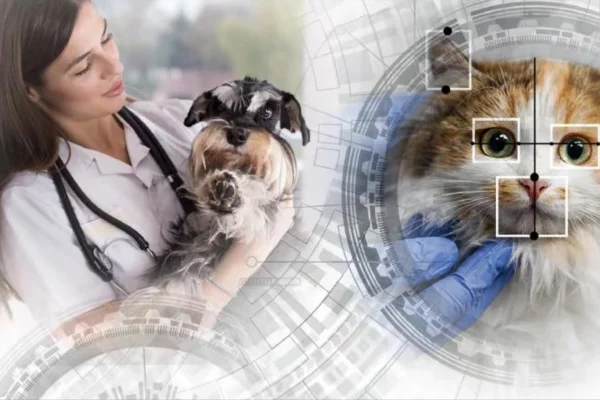The Artificial Intelligence Revolution in Veterinary Medicine
Introduction
Artificial intelligence (AI) has transformed many areas of knowledge, and veterinary medicine is no exception. With large-scale data processing and analysis capabilities, AI offers new perspectives for animal health, from diagnosis to treatment and disease prevention.
This article explores the main applications of AI in veterinary medicine, highlighting its revolutionary potential and the ethical and practical challenges that accompany its implementation.
What is Artificial Intelligence?
AI is a field of study dedicated to developing systems capable of performing tasks that normally require human intelligence, such as pattern recognition, learning and decision-making. In veterinary medicine, AI uses data collected from various sources, such as medical records, animal sensors and production information, to generate valuable insights.
Contents
Applications of AI in Veterinary Medicine
1. Diagnosis and Prognosis
One of the most promising areas of AI in veterinary medicine is the diagnosis and prognosis of diseases. Advanced algorithms can analyze medical images, such as X-rays and ultrasounds, to identify anomalies that may go unnoticed by the human eye. In addition, AI can predict the evolution of diseases based on historical data patterns, allowing for more precise and timely interventions.
2. Precision Medicine
Precision medicine aims to personalize treatment for each animal based on its individual characteristics. AI facilitates this approach by analyzing genetic, clinical and environmental data to determine the best course of action. This can include selecting specific drugs or adapting treatment regimens to maximize efficacy and minimize side effects.
3. Health monitoring
AI-equipped sensors and monitoring devices can collect continuous data on animal health. These devices can measure parameters such as body temperature, heart rate and activity levels, sending alerts to vets in the event of anomalies. This continuous monitoring is especially useful for detecting diseases in the early stages and preventing complications.
4. Herd Management
In animal production environments, AI can optimize herd management by analyzing production and health data in real time. This includes monitoring animals' diet, reproduction and health conditions. By identifying patterns and trends, AI can suggest management improvements to increase productivity and animal welfare.

Challenges and Ethical Considerations
While the advantages of AI in veterinary medicine are clear, there are significant challenges to overcome. Data quality is crucial to the effectiveness of AI algorithms. Incomplete or inaccurate data can lead to misdiagnoses and inappropriate treatments. In addition, there are ethical concerns related to data privacy and the use of AI in critical health decisions.
1. Data Quality
Collecting and integrating high-quality data is essential to the effectiveness of AI systems. This includes ensuring that the data is accurate, up-to-date and representative. Standardization of data formats and interoperability between different information systems are also important for maximizing the benefits of AI.
2. Privacy and Data Security
Protecting the privacy of data on animals and their owners is a key concern. Robust security measures must be implemented to prevent unauthorized access and misuse of information. In addition, transparency about how data is collected, stored and used is key to gaining the trust of pet owners.
3. Ethical implementation
The ethical implementation of AI in veterinary medicine requires a balanced approach that considers the benefits and risks. Veterinarians must be actively involved in the development and evaluation of these technologies to ensure that they are used responsibly and for the benefit of the animals.
The Future of AI in Veterinary Medicine
The future of AI in veterinary medicine is promising. As technology advances, new applications and continuous improvements are expected to make AI an indispensable tool in veterinary practice. Collaboration between animal health professionals, researchers and technology developers will be crucial to exploit the full potential of AI and meet the challenges that arise.
1. emerging innovations
New innovations are being developed, including the use of AI for advanced genetic analysis, the prediction of epidemics and the personalization of treatments. These technologies promise to further transform veterinary medicine, providing more effective and efficient care.
2. Education and Training
For AI to be fully integrated into veterinary practice, it is essential to invest in education and training. Veterinary professionals must be trained to use and interpret AI tools, ensuring that they can make the most of these technologies for the benefit of the animals.
3. Interdisciplinary collaboration
Collaboration between different disciplines, including veterinary science, computer science, biology and ethics, will be key to the success of AI in veterinary medicine. This multidisciplinary approach will enable the development of innovative and practical solutions that address animal health needs in a holistic way.

Conclusion - Artificial intelligence in veterinary medicine
Artificial intelligence has the potential to revolutionize veterinary medicine, offering new tools and approaches for diagnosing, treating and preventing diseases. Although there are significant challenges to overcome, the opportunities are vast and promising. With ethical implementation and interdisciplinary collaboration, AI can make a significant contribution to animal health and welfare, marking a new era in veterinary medicine.
References
- Ezanno, P., Picault, S., Beaunée, G. et al. Research perspectives on animal health in the era of artificial intelligence. Vet Res 52, 40 (2021).
- Joslyn, S., Alexander, K. Evaluating artificial intelligence algorithms for use in veterinary radiology. Vet Radiol Ultrasound. 2022; 63(Suppl. 1): 871-879.
Thanks for stopping by, check out our other work too
https://cuidar.petlove.com.br/gatos
https://vettopbr.com/tosse-em-caes/








